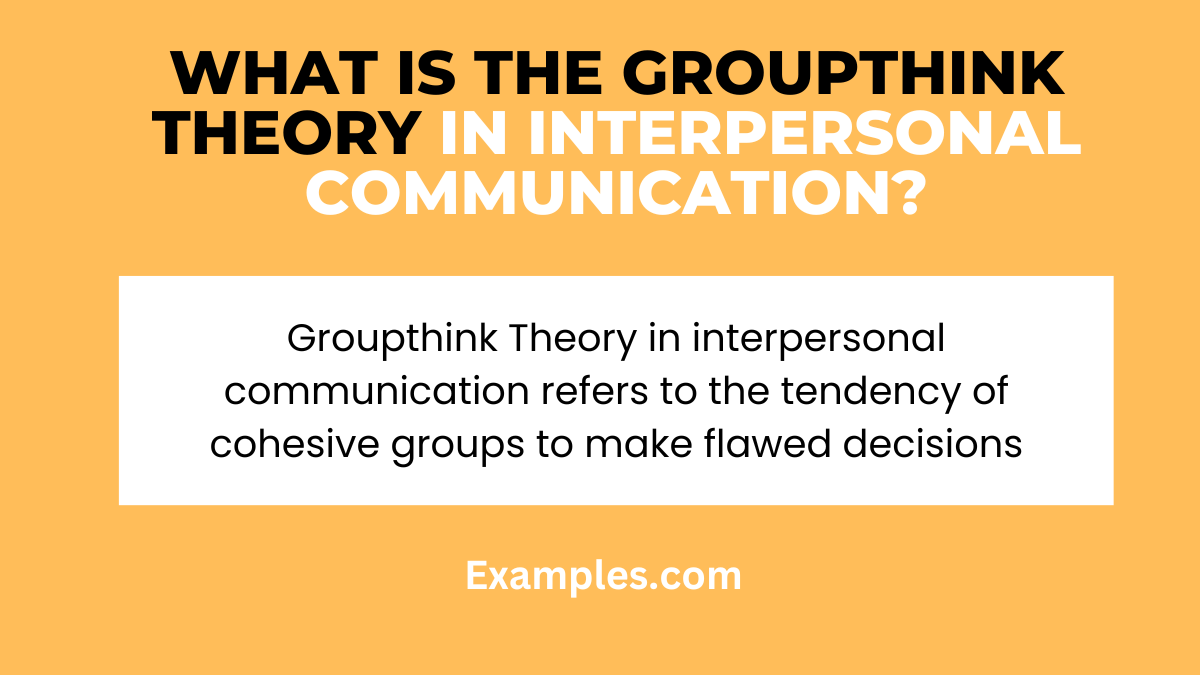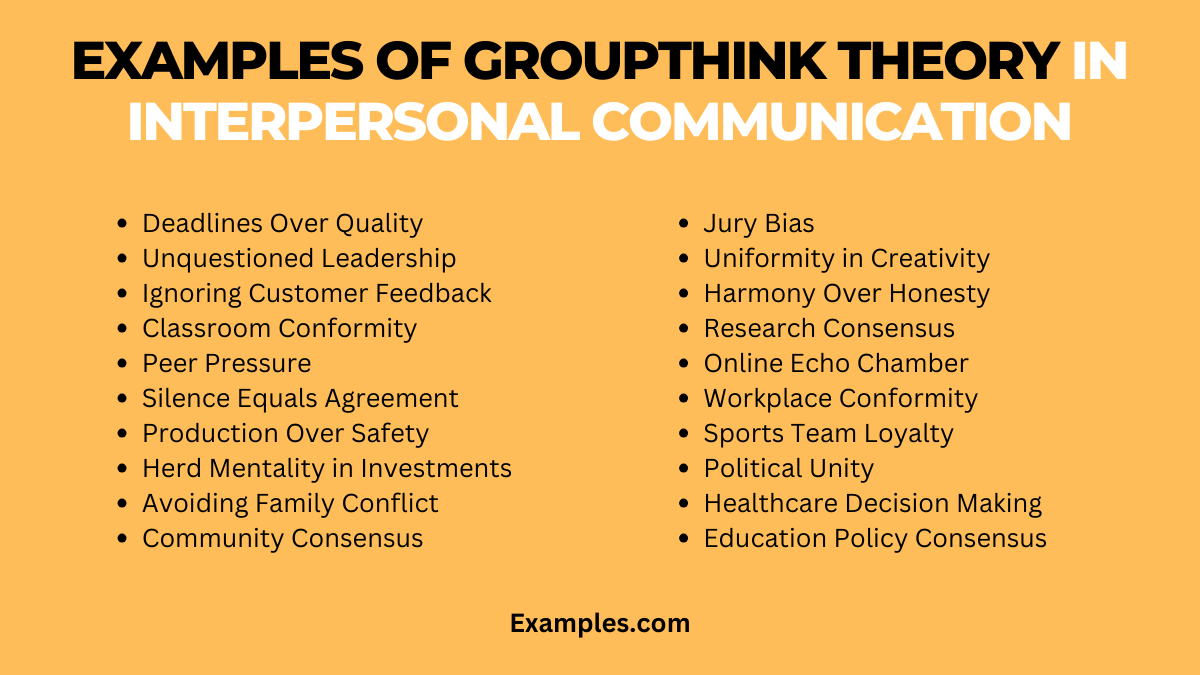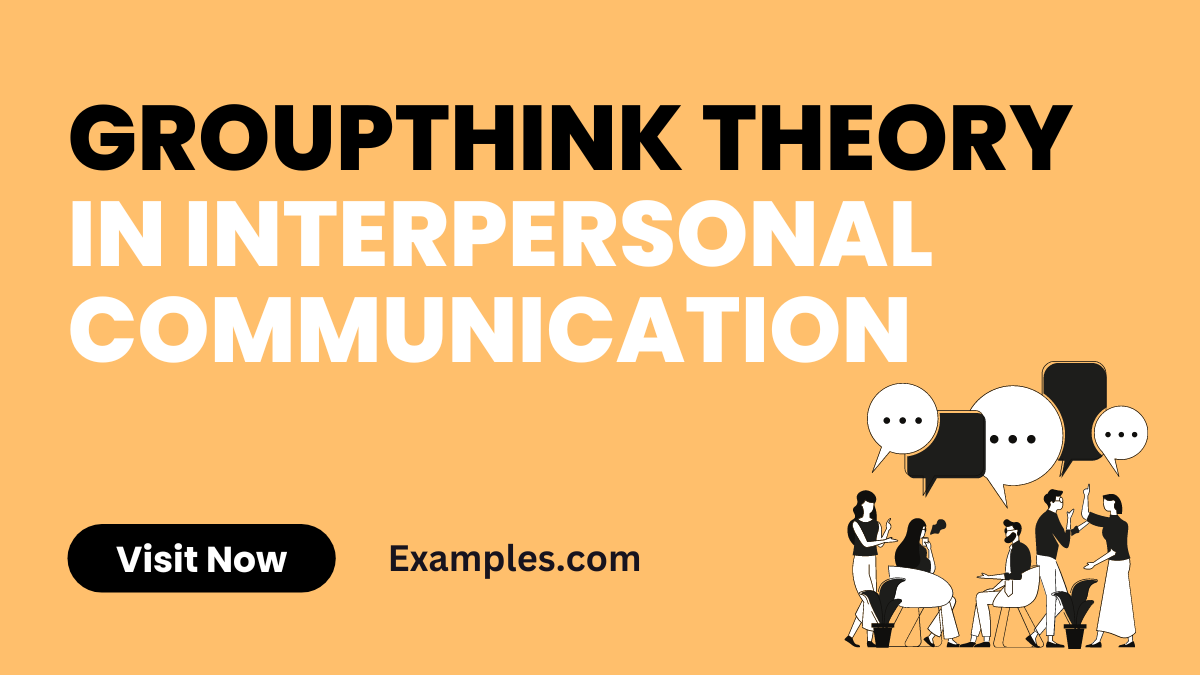19+ Groupthink Theory in Interpersonal Communication Examples
Groupthink Theory in Interpersonal Communication plays a pivotal role in shaping how we interact and make decisions in groups. This comprehensive guide delves into the intricacies of this theory, shedding light on its profound impact on our daily conversations and decision-making processes. Whether in professional settings or personal relationships, understanding this theory can significantly enhance our communication skills and group dynamics.
What is the Groupthink Theory in Interpersonal Communication?

Groupthink, a term coined by psychologist Irving Janis in 1972, refers to a psychological phenomenon where the desire for harmony and conformity in a group results in irrational or dysfunctional decision-making outcomes. In the realm of Interpersonal Communication, groupthink manifests when group members suppress dissenting opinions, leading to a loss of individual creativity and independent thinking. This often results in the group making sub-optimal or flawed decisions.
History
Who Created: Irving Janis
Date: 1972
Janis analyzed historical events like the Pearl Harbor attack and the Bay of Pigs invasion to demonstrate how groupthink led to disastrous outcomes. He identified several symptoms of groupthink, such as illusions of invulnerability, collective rationalization, and the suppression of opposing viewpoints, which can hinder the Interpersonal Communication process in groups.
What is the Best Example of Groupthink Theory in Interpersonal Communication?
One of the best examples of groupthink in Interpersonal Communication can be seen in corporate boardrooms where decisions are made. When all members of a board agree without questioning the leader’s opinion, or when dissenting voices are silenced to maintain harmony, the group is likely experiencing groupthink. This scenario highlights the need for encouraging open dialogue and diverse viewpoints in Types of Interpersonal Communication to avoid poor decision-making.
20 Examples of Groupthink Theory in Interpersonal Communication

Groupthink theory, a vital concept in Interpersonal Communication, highlights how group consensus often overrides individual creativity and critical thinking. This phenomenon affects various communication types, including verbal, non-verbal, and digital formats. Understanding groupthink is crucial for effective interpersonal interaction, fostering diverse perspectives and healthier decision-making processes.
- Meeting Deadlines Over Quality: In a team project, members agree to a subpar solution to meet deadlines, ignoring better alternatives.
Example: “Let’s just go with this idea to keep on schedule.” - Unquestioned Leadership Decisions: Team members agree with a leader’s decision without discussion, fearing conflict.
Example: “The boss suggested this, so it must be right.” - Ignoring Customer Feedback in Marketing: A marketing team disregards negative customer feedback, believing in their initial strategy.
Example: “Our plan is solid; those customer concerns aren’t significant.” - Conformity in Classroom Settings: Students agree with a popular opinion in class discussions to avoid standing out.
Example: “I guess I agree with what everyone else thinks.” - Peer Pressure in Social Groups: Friends agree to a risky plan to maintain group harmony.
Example: “We all are in this together, right?“ - Silence Equals Agreement in Meetings: Employees remain silent in meetings, assuming silence means agreement.
Example: “No one objected, so we all must agree.” - Overlooking Safety for Production Goals: A manufacturing team ignores safety concerns to meet production targets.
Example: “Let’s not complicate things; just keep the production going.” - Herd Mentality in Investment Decisions: Investors follow popular trends, ignoring individual analysis.
Example: “Everyone is investing in this, so it must be good.” - Avoiding Conflict in Family Decisions: Family members agree to a decision to avoid arguments, even if they disagree.
Example: “Let’s just do it your way to keep peace in the family.” - Consensus in Community Projects: Community members support a popular project, despite having reservations.
Example: “It seems like everyone else supports it, so I will too.” - Group Bias in Jury Deliberations: Jurors agree with the majority to expedite the process, ignoring personal doubts.
Example: “I’ll just go with the majority to finish this quickly.” - Uniformity in Creative Teams: Creative teams favor familiar ideas over innovative ones to maintain group cohesion.
Example: “Let’s stick with what we know works.“ - Harmony Over Honesty in Relationships: Partners avoid discussing issues to maintain a false sense of harmony.
Example: “I won’t bring it up; I don’t want to start a fight.“ - Consensus in Academic Research Teams: Researchers agree on a conclusion to maintain unity, despite conflicting data.
Example: “Let’s not complicate our findings; let’s agree on this.” - Echo Chamber in Online Forums: Online communities reinforce existing beliefs, discouraging opposing viewpoints.
Example: “Everyone here agrees, so this must be true.” - Conformity in Workplace Culture: Employees adopt workplace norms, even if they conflict with personal values.
Example: “This is just how things are done here.“ - Group Loyalty in Sports Teams: Players agree with team strategies, even if they see flaws, to show loyalty.
Example: “I have my doubts, but I’ll support the team’s decision.” - Avoiding Dissent in Political Parties: Party members support policies they privately disagree with to present a united front.
Example: “I have reservations, but I’ll toe the party line.” - Uniform Decision Making in Healthcare Teams: Healthcare professionals agree with senior staff decisions, even if unsure.
Example: “The senior doctor thinks it’s best, so it must be.” - Consensus in Educational Policy: Educators agree to new policies for conformity, ignoring potential issues.
Example: “Let’s not be the ones to rock the boat; let’s agree.“
What is the Groupthink Theory in Interpersonal Communication in the Workplace?
Groupthink theory in interpersonal communication, particularly in the workplace, is a significant phenomenon that impacts decision-making processes and team dynamics. Here are eight key points to understand this theory:
- Definition of Groupthink: Groupthink occurs when a group values harmony and coherence over accurate analysis and critical evaluation. It often leads to irrational and dehumanizing actions against “out-groups.”
- Pressure to Conform: In groupthink scenarios, there is often an implicit or explicit pressure for members to agree with the group’s decisions, stifling individual creativity and independent thinking.
- Illusion of Unanimity: Groupthink creates a false sense of agreement or consensus, where dissenting opinions are either not voiced or are suppressed by the group.
- Self-Censorship: Members of the group avoid raising controversial or non-conforming ideas due to the fear of disrupting the group’s harmony or being ostracized.
- Mind Guards: Some group members act as ‘mind guards’, protecting the group from adverse information or opinions that might disrupt group complacency.
- Illusion of Invulnerability: Groups under the influence of groupthink often develop an over-optimistic view of their decisions and actions, underestimating potential risks and challenges.
- Direct Pressure on Dissenters: Members who express doubts or differing views may face direct pressure from others in the group to conform or align with the majority view.
- Stereotyping the Out-Group: There is often a tendency to stereotype and dismiss the opinions of anyone outside the group, further reinforcing the group’s existing perspectives.
Perspectives of Groupthink Theory in Interpersonal Communication
Groupthink theory in interpersonal communication can be examined from various perspectives. Here are eight points to consider:
- Psychological Perspective: Groupthink arises from the inherent desire of human beings to avoid conflict and maintain smooth interpersonal relations.
- Organizational Behavior: In the context of an organization, groupthink can lead to poor decision-making and can hamper innovation and growth.
- Leadership Role: Leaders play a crucial role in either facilitating or mitigating groupthink by encouraging open dialogue and dissenting opinions.
- Cultural Influence: Cultural norms and values, such as high power distance or collectivism, can contribute to a higher likelihood of groupthink occurring in certain environments.
- Communication Channels: The modes of Interpersonal Communication, such as Verbal Communication in Interpersonal Communication or Digital Communication in Interpersonal Communication, can influence the occurrence and impact of groupthink.
- Team Dynamics: The composition and dynamics of a team, including factors like group size, homogeneity, and cohesiveness, significantly affect the propensity for groupthink.
- Historical Instances: Studying historical instances of poor decision-making due to groupthink provides valuable insights into its impact and consequences.
- Strategies to Counteract: Recognizing the need for strategies like promoting diverse teams, fostering an open communication culture, and encouraging critical thinking to mitigate groupthink.
Tips for Groupthink Theory in Interpersonal Communication
Here are eight practical tips to prevent or minimize groupthink in interpersonal communication scenarios:
- Encourage Open Debate: Cultivate an environment where dissenting opinions are valued and encouraged.
- Diverse Teams: Create teams with diverse backgrounds and perspectives to avoid homogeneous thinking.
- Appoint a Devil’s Advocate: Regularly assign someone the role of a devil’s advocate to question and challenge prevailing group norms and decisions.
- Anonymous Feedback: Implement anonymous feedback mechanisms to allow team members to express their concerns without fear of retribution.
- Leadership Stance: Leaders should refrain from stating preferences or expectations at the outset to avoid unduly influencing the group.
- Training: Regular training on the importance of Types of Interpersonal Communication and the pitfalls of groupthink can be beneficial.
- Sub-Groups: Break larger groups into smaller, independent sub-groups to discuss and debate before making decisions.
- Review Mechanisms: Set up regular review mechanisms to critically assess decisions and policies for signs of groupthink.
Groupthink Theory is vital for effective interpersonal communication. By following the provided guide and tips, you can write about this theory with clarity and depth. Remember to emphasize the dangers of group conformity, encourage critical thinking, and foster an environment that values diverse perspectives in communication processes.



